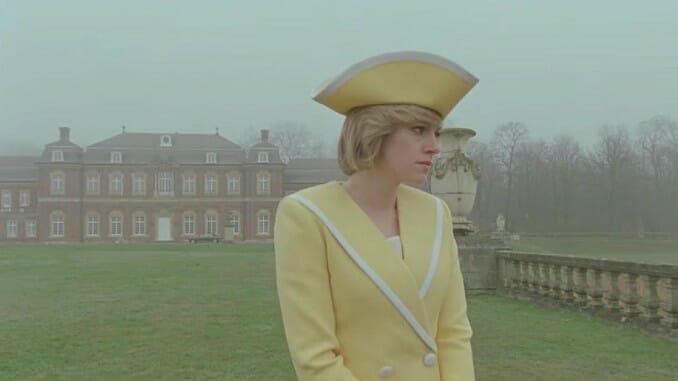Beguiling Yet Hollow, Spencer Reduces Princess Diana to Cultural Currency

Throughout Spencer’s two-hour runtime, Queen Elizabeth (Stella Gonet) and Princess Diana (Kristen Stewart) only exchange words once. During their brief conversation, the Queen slyly remarks that the press have a particular fondness for taking photos of Diana. She then tells her daughter-in-law that the only portrait that actually matters in a princess’s life is the one that is taken to print on money when she becomes a queen. That moment, she explains, reminds you that you are merely currency.
By the time the two finally congregate, the audience has been breathlessly awaiting an encounter between Diana and the mythical, apparently formidable queen for nearly half of the film’s runtime. Paired with Jonny Greenwood’s haunting, ominous score, interactions between Diana and just about everyone in Spencer—the frosty Gonet; Jack Farthing, who plays Diana’s famously unfaithful husband Prince Charles; and the always ornery Timothy Spall as the delightfully inhospitable Major Alistair Gregory—are shrouded with an air of acrimony. Through these performances, not least of which is Stewart’s cowering portrayal of Diana, director Pablo Larraín does not allow us to forget the positions of these characters. Diana is the victim. The Royal Family, her oppressors.
Given these already established power dynamics, though, the scene between Diana and the Queen comes across as…odd. Instead of a hostile indictment of Diana’s fame, the Queen’s words come off as refreshingly honest—protective, even. And here lies a critical contradiction in Spencer. While the Royals are perceived by Diana as stifling tyrants, the worst thing they do in the film is repeatedly ask her to come down for dinner.
Indeed, more than anything, the Queen’s statement draws attention to Larraín’s characterization of Diana herself. In a number of ways, the choices he makes in recreating her character do reduce her to a currency of sorts. Larraín’s depiction of Diana is tragic and not particularly flattering. Set in 1991, Spencer takes place in Sandringham as the Royals congregate to celebrate Christmas. At the time, Diana and Charles’s marriage was publicly crumbling, which placed Diana under a hailstorm of scrutiny. The film’s version of Diana is written to be ripe with vanity and insecurity, her bulimia and self-harm pushed to the forefront. With each fleeting glance, Stewart brilliantly, subtly navigates the paranoia, anger and melancholy that Diana is experiencing. But more than anything, Stewart plays her with trembling fragility. This Diana is presented as a victim: One helpless at the conniving hands of the royals. The script, which constantly circles back to gloomy comments made by Diana about her situation, paired with Stewart’s inordinately forlorn expressions, makes it difficult to interpret the power dynamic any other way. It is worth noting, too, that people close to Diana have recounted that during the time period Spencer is set, Diana’s personality was nothing like that portrayed in the film. Instead, she was overwhelmingly disarming and confident. The divergence from reality here allows Larraín to twist Diana into the character he wants to depict, and push Spencer in the direction of a moody, ghostly fairytale. But in favoring style, he also flattens a nuanced story.
-

-

-

-

-

-

-

-

-

-

-

-

-

-

-

-

-

-

-

-

-

-

-

-

-

-

-

-

-

-

-

-

-

-

-

-

-

-

-

-








































